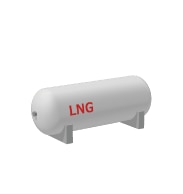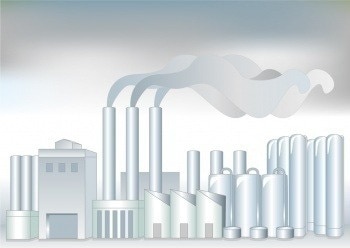What is an aerosol?
Definition of aerosol
An aerosol is a suspension of fine solid particles in atmospheric air.
Aerosols are often not or barely visible to the human eye and recently we often hear them called as PM10 (particle size less than 10μm), PM2.5 (particle size less than 2.5μm), etc. according to the size of particles.
Aerosols are often not or barely visible to the human eye and recently we often hear them called as PM10 (particle size less than 10μm), PM2.5 (particle size less than 2.5μm), etc. according to the size of particles.



Particles originated in coal, oil, natural gas, etc. may bring harmful effect to humans because those particle size are very small and possible to come deep into the lungs.
Aerosols can be generated from both natural processes, such as sea spray and dust storms, and human activities including pollution from vehicles and industrial emissions.
Aerosols can be generated from both natural processes, such as sea spray and dust storms, and human activities including pollution from vehicles and industrial emissions.

Aerosols generated from industrial process
Characteristics of Aerosols
Size:
Aerosol particles generally have diameters less than 1 micrometer (μm), allowing them to remain suspended in the atmosphere for extended periods. They can vary in size, with classifications such as PM2.5 (particles smaller than 2.5 μm) and PM10 (particles between 2.5 and 10 μm) being common in environmental science.
Types:
Aerosols can be classified into primary aerosols, which are emitted directly into the atmosphere (e.g., dust, smoke), and secondary aerosols, which form from chemical reactions in the atmosphere (e.g., sulfate aerosols from sulfur dioxide emissions).
Impact on Climate and Health
Aerosols play a significant role in climate dynamics by influencing cloud formation and solar radiation absorption and may also impact to health issues because fine particulate matter can penetrate deep into the lungs and enter the bloodstream which may lead to various respiratory and cardiovascular problems.
Impact on Climate
Aerosols have a complex and significant impact on climate change.
Typical impacts are cooling effect and warming effect on Earth's climate.
Typical impacts are cooling effect and warming effect on Earth's climate.
Cooling Effects
Most aerosols have an overall cooling effect on the Earth's climate:
- They reflect incoming sunlight back to space before it reaches the Earth's surface and it results reducing the amount of solar energy absorbed.
- Light-colored aerosols like sulfates from volcanic eruptions or air pollution can block sunlight and cool the atmosphere.
- Some aerosols interact with clouds, making water droplets smaller and clouds more reflective, further enhancing cooling
- They reflect incoming sunlight back to space before it reaches the Earth's surface and it results reducing the amount of solar energy absorbed.
- Light-colored aerosols like sulfates from volcanic eruptions or air pollution can block sunlight and cool the atmosphere.
- Some aerosols interact with clouds, making water droplets smaller and clouds more reflective, further enhancing cooling
Warming Effects
On the other hand, some aerosols can contribute to warming:
- Dark-colored aerosols like black carbon (soot) absorb sunlight and warm the atmosphere.
- While absorbing aerosols reduce sunlight at ground level, they heat up the atmosphere and can eventually warm the surface.
- Dark-colored aerosols like black carbon (soot) absorb sunlight and warm the atmosphere.
- While absorbing aerosols reduce sunlight at ground level, they heat up the atmosphere and can eventually warm the surface.
Impact on Health
Aerosols, which are tiny particles suspended in the air, can significantly impact human health through various mechanisms. The health effects by aerosols largely depend on their size, composition and concentration in the environment.
Respiratory and Cardiovascular Effects
Respiratory System:
Inhalation of aerosols can lead to respiratory problems as these particles can penetrate deep into the lungs and, depending on their size, even enter the bloodstream. This can result in acute and chronic respiratory illnesses, including asthma, bronchitis, and chronic obstructive pulmonary disease (COPD).
Cardiovascular System:
Aerosols are also linked to cardiovascular issues. Prolonged exposure to particulate matter in aerosols can increase the risk of heart attacks, strokes, and other cardiovascular diseases. Studies have shown that exposure to aerosols can aggravate pre-existing cardiovascular conditions and increase mortality rates due to cardiorespiratory causes.
Other Health Impacts
Infectious and Allergic Reactions:
Bioaerosols, which include microbial particles, can cause infections and allergic reactions. These particles can carry pathogens and allergens that lead to diseases such as hypersensitivity pneumonitis and other allergic conditions.
Toxicological Effects:
Some aerosols contain toxic substances that can lead to toxicological responses in the body. These can include irritation of the eyes, skin, and respiratory tract, as well as systemic effects if the toxins enter the bloodstream.
Factors Influencing Health Impacts
The health effects of aerosols are influenced by several factors, including:
Particle Size:
Smaller particles can penetrate deeper into the lungs and have more severe health effects compared to larger particles that are typically trapped in the upper respiratory tract.
Exposure Duration:
Both short-term and long-term exposures to aerosols can have health impacts, but chronic exposure is associated with more severe outcomes such as increased mortality from cardiorespiratory diseases.
Environmental and Individual Factors:
The impact of aerosols can vary based on environmental conditions (e.g., urban vs. rural settings) and individual factors such as age, health status, and pre-existing conditions.
Aerosol Monitoring Techniques
Monitoring aerosols involves a combination of ground-based, airborne, and satellite-based techniques to provide comprehensive data on their distribution, composition, and impacts. Key methods include:
- Satellite observations: Instruments like MODIS, MISR, and CALIPSO provide global coverage of aerosol optical depth (AOD) and other properties.
- These measurements offer valuable insights into large-scale aerosol distribution and transport patterns.Ground-based networks: AERONET, a global network of sun photometers, measures AOD with high accuracy, validating satellite data and providing detailed local measurements.
- Other ground-based instruments like lidar systems offer vertical profiles of aerosol properties.
- Advanced analytical techniques: Ion chromatography and mass spectrometry enable real-time, high-resolution analysis of aerosol chemical composition.
- The Particle Into Liquid Sampler (PILS) allows for rapid measurement of water-soluble aerosol components.
These diverse monitoring approaches, combined with sophisticated data analysis, allow scientists to track aerosol sources, assess their impacts on air quality and climate, and inform pollution mitigation strategies.
Field sensor for monitoring ambient aerosols
As described above, aerosols have significant impact on human health (as well as quality on industrial production process). So it is required to monitor environmental situation (concentration of aerosols) in the ambient air with continuous monitoring equipment according to the place and situation.

Following are some references of those continuous monitoring equipment.
Please feel free to ask us if you have any questions
or you want our support. ⇩⇩⇩
Please feel free to contact us if you have any inquiries.
Click here to download documents.
© Matsushima Measure Tech Co., Ltd.



